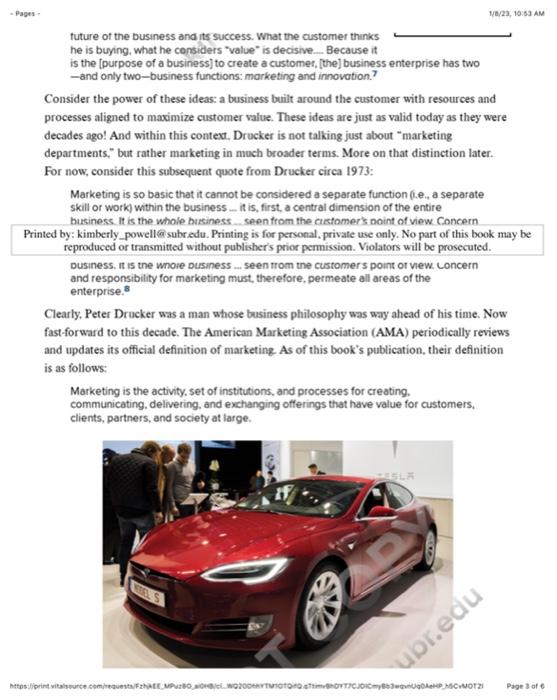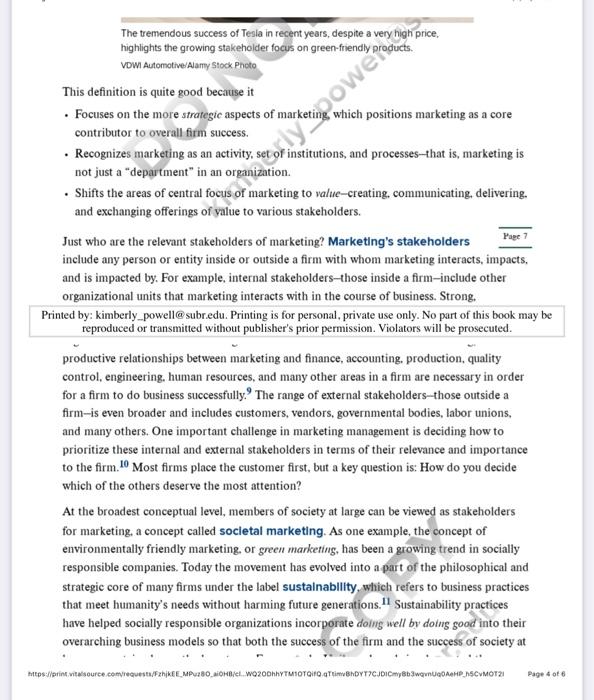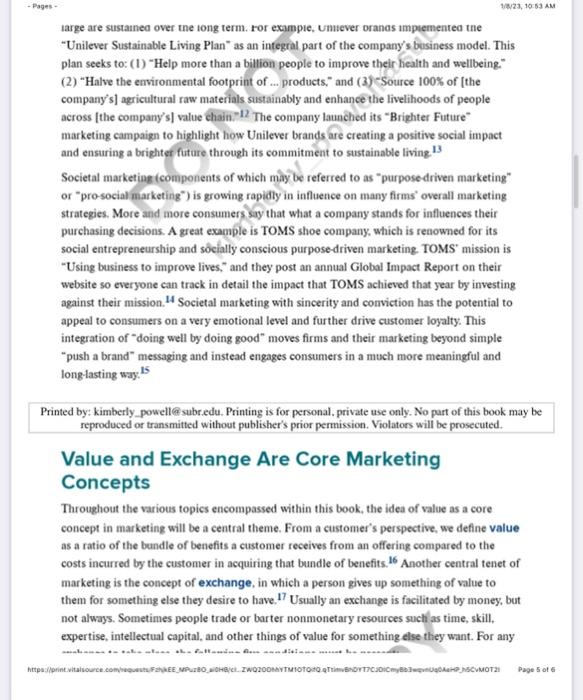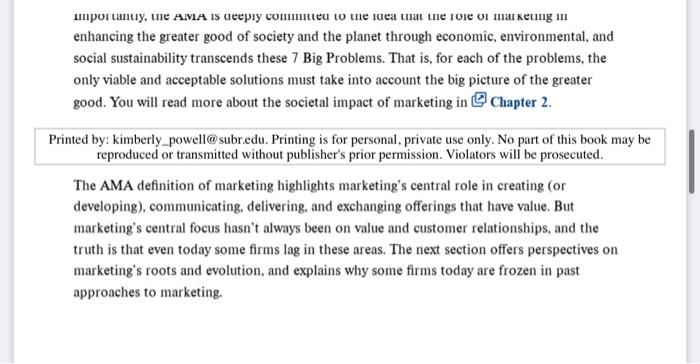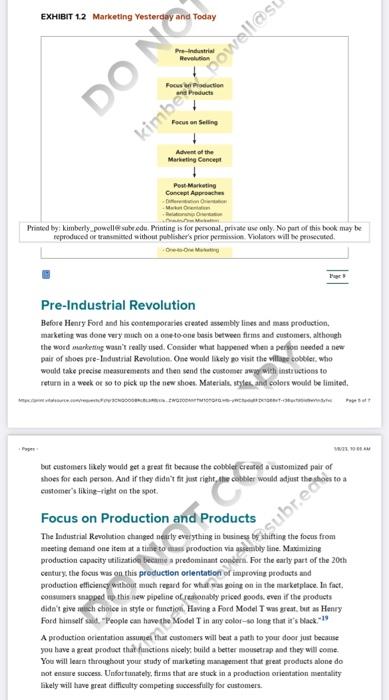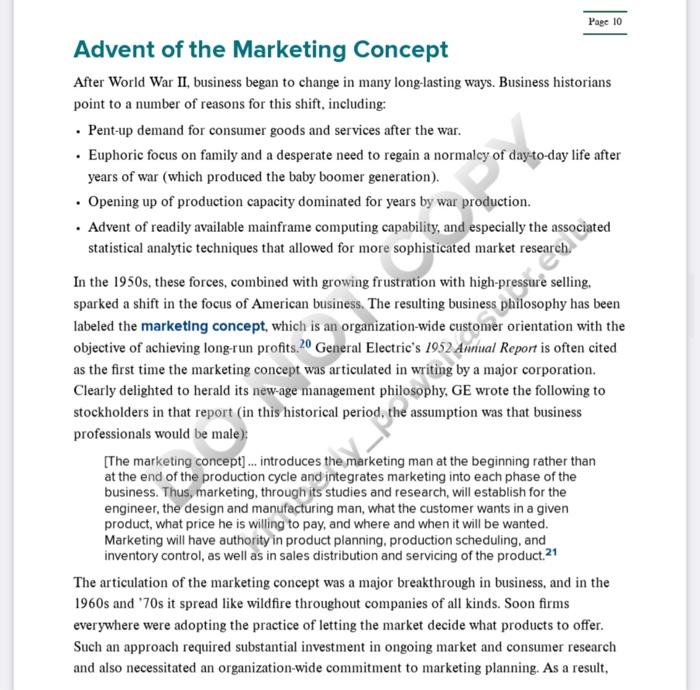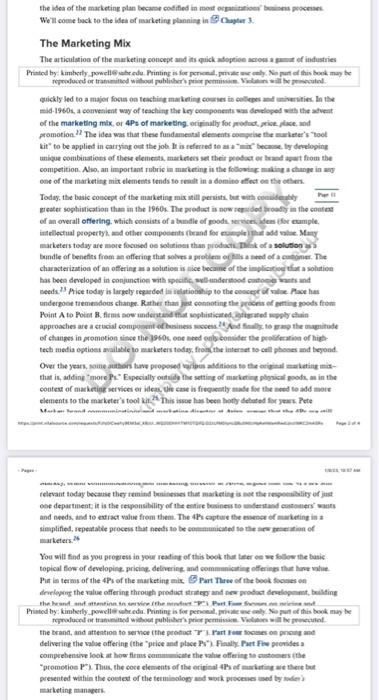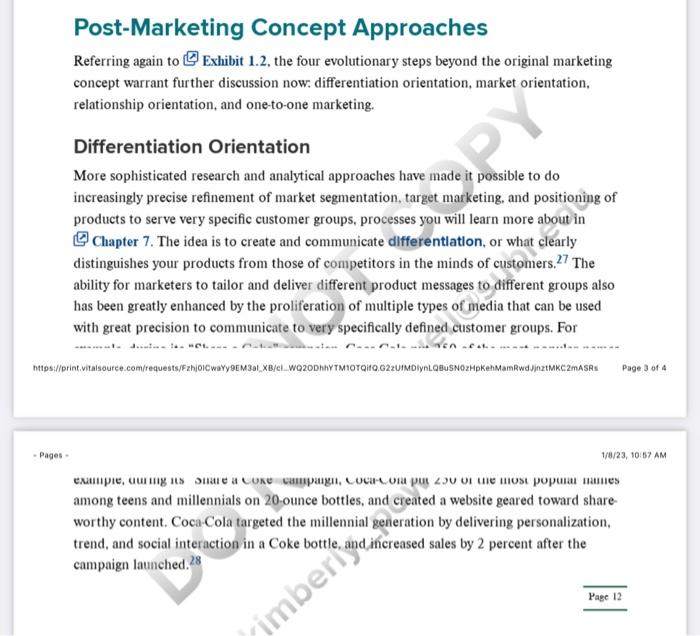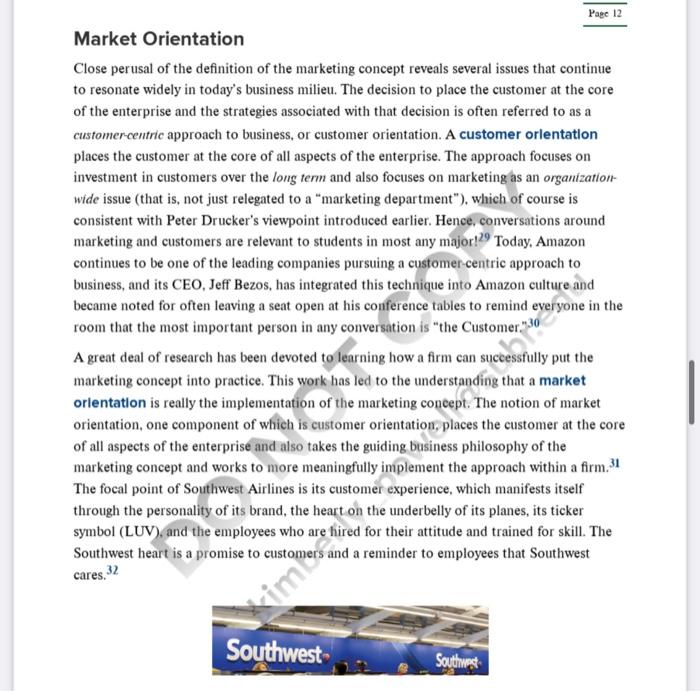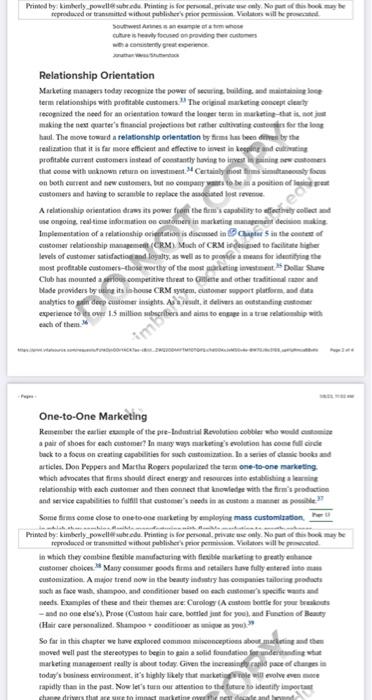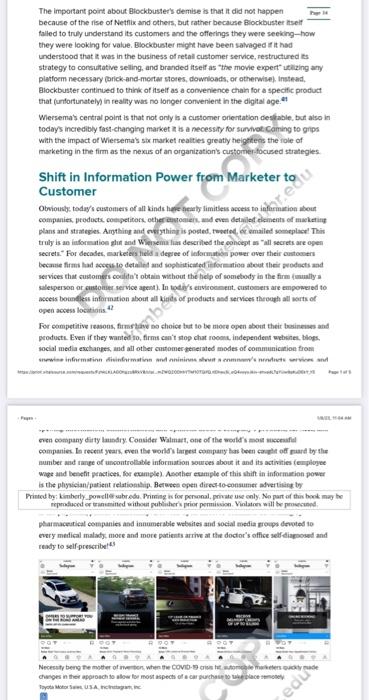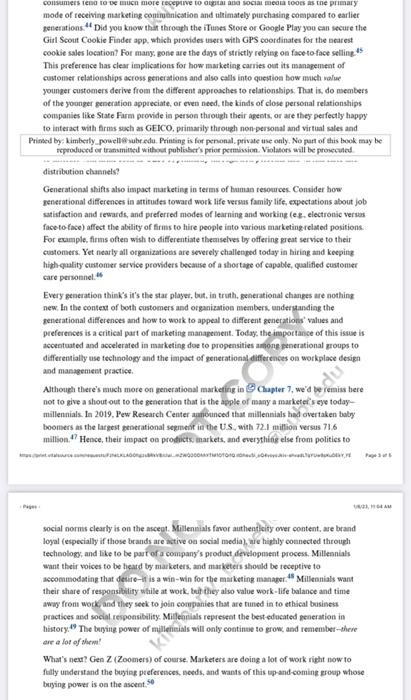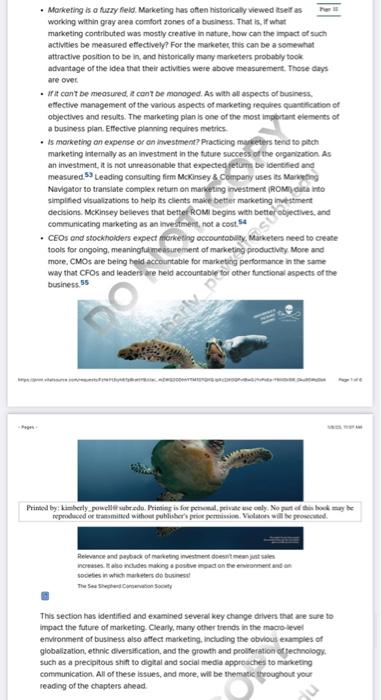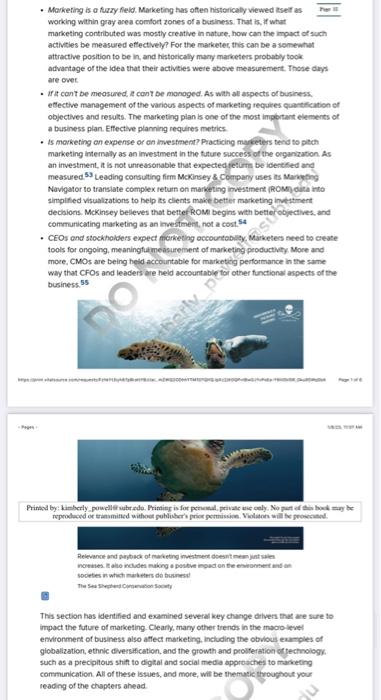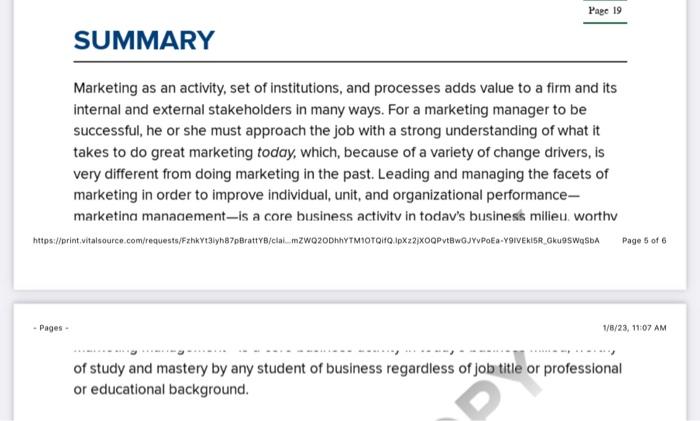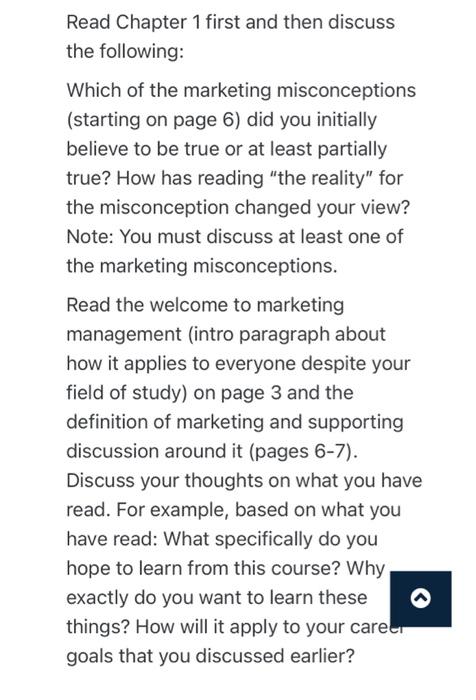The chapters that follow lay the groundwork for developing the knowledge and Yage6 skills around marketing that will allow you to build a more successful career as a leader and manager, regardless of your department, area of specialization, level in the organization, or job title. Is marketing relevant to you? You bet it is, because everyone in an organization does marketing in some way and must share ownership of its success or failure. Learning about marketing management is not just about reading a book or taking a course, although dedication to these activities is a great starting point Instead, great marketing is a lifelong journey that requires dedication to continuous learning and improvement of your knowledge and skills as a leader and manager. It is in this spirit that we enthusiastically invite you to begin your journey into the field of marketing managementl DEFINING MARKETING Every business student should know about Peter Drucker. Several decades ago, the late management guru who is often referred to as "the father of modern management," set the stage for defining contemporary marketing and conceiving of its potential power. Consider this quote from Drucker, circa 1954 (emphasis added): If we want to know what a business is we have to start with its purpose. There is only one valid definition of business purpose: to create a customer. It is the customer who determines what a business is. For it is the customer, and he alone, who through being willing to pay for a good or service, converts economic resources into wealth, things into goods. What the business thinks it produces is not of first importance-especially not to the https://print.vitalsource.com/requests/FzhjkEE_MPuzBO_ai0HE/cl..._WQ2ODhhYTM1OTQifQ.qTtimvBhDYT7C.JDiCmyBb3wqvnUqQAeHP_h5CvMOT21 future of the business and its success. What the customer thinks he is buying, what he considers "value" is decisive.. Because it is the [purpose of a business] to create a customer, [the] business enterprise has two -and only two-business functions: marketing and innovotion. 7 Consider the power of these ideas: a business built around the customer with resources and processes aligned to maximize customer value. These ideas are just as valid today as they were decades ago! And within this context. Drucker is not talking just about "marketing departments." but rather marketing in much broader terms. More on that distinction later. For now, consider this subsequent quote from Drucker circa 1973: Marketing is so basic that it cannot be considered a separate function (i.e., a separate skill or work) within the business . it is, first, a central dimension of the entire business. It is the whole bursiness. seen from the curstomer's noint of view Concern. Printed by: kimberly, powella subr edu. Printing is for personal, private use only. No part of this book may be reproduced or transmitted without publisher's prior permission. Violators will be prosecuted. Dusiness. it is the Whose Dusiness .. seen trom the customers point or view. Loncern and responsibility for marketing must, therefore, permeate all areas of the enterprise. 8 Clearly, Peter Drucker was a man whose business philosophy was way ahead of his time. Now fast-forward to this decade. The American Marketing Association (AMA) periodically reviews and updates its official definition of marketing. As of this book's publication, their definition is as follows: Marketing is the activity, set of institutions, and processes for creating. communicating. delivering, and exchanging offerings that have value for customers. clients, partners, and society at large. The tremendous success of Tesla in recent years, despite a very high price, highlights the growing stakeholder focus on green-friendly products. VDW Automotive'Alarry Stock Photo This definition is quite good because it - Focuses on the more strategic aspects of marketing, which positions marketing as a core contributor to overall firm success. - Recognizes marketing as an activity, set of institutions, and processes-that is, marketing is not just a "depaytment" in an organization. - Shifts the areas of central focus of marketing to value-creating, communicating, delivering. and exchanging offerings of value to various stakeholders. Just who are the relevant stakeholders of marketing? Marketing's stakeholders include any person or entity inside or outside a firm with whom marketing interacts. impacts. and is impacted by. For example, internal stakeholders-those inside a firm-include other organizational units that marketing interacts with in the course of business. Strong. Printed by: kimberly_powell@subr.edu. Printing is for personal, private use only. No part of this book may be reproduced or transmitted without publisher's prior permission. Violators will be prosecuted. productive relationships between marketing and finance, accounting, production, quality control, engineering. human resources, and many other areas in a firm are necessary in order for a firm to do business successfully. 9 The range of external stakeholders-those outside a firm-is even broader and includes customers, vendors, governmental bodies, labor unions, and many others. One important challenge in marketing management is deciding how to prioritize these internal and external stakeholders in terms of their relevance and importance to the firm. 10 Most firms place the customer first, but a key question is: How do you decide which of the others deserve the most attention? At the broadest conceptual level, members of society at large can be viewed as stakeholders for marketing, a concept called socletal marketing. As one example, the concept of environmentally friendly marketing, or green marketing, has been a growing trend in socially responsible companies. Today the movement has evolved into a part of the philosophical and strategic core of many firms under the label sustalnabllity, which refers to business practices that meet humanity's needs without harming future generations. 11 Sustainability practices have helped socially responsible organizations incorporate dolng well by doing good into their overarching business models so that both the success of the firm and the success of society at targe are sustained over the tong term. For exampie, Umiever oranas impiemented the "Unilever Sustainable Living Plan" as an integral part of the company's besiness model. This plan seeks to: (1) "Help more than a billion people to improve their health and wellbeing." (2) "Halve the environmental footprint of ... products," and (3)-Source 100% of [the company's] agricultural raw materials sustainably and enhance the livelihoods of people across [the company's] value chain."12 The company launched its "Brighter Future" marketing campaign to highlight how Unilever brands are creating a positive social impact and ensuring a brighter future through its commitment to sustainable living 13 Societal marketing (components of which may be referred to as "purposedriven marketing" or "pro-social marketing") is growing rapidly in influence on many firms' overall marketing strategies. More and more consumers siy that what a company stands for influences their purchasing decisions. A great example is TOMS shoe company, which is renowned for its social entrepreneurship and socially conscious purposedriven marketing. TOMS' mission is "Using business to improve lives," and they post an annual Global Impact Report on their website so everyone can track in detail the impact that TOMS achieved that year by investing against their mission. 14 Societal marketing with sincerity and conviction has the potential to appeal to consumers on a very emotional level and further drive customer loyalty. This integration of "doing well by doing good" moves firms and their marketing beyond simple "push a brand" messaging and instead engages consumers in a much more meaningful and long-lasting way. 15 Printed by: kimberly powell subr.edu. Printing is for personal, private use only. No part of this book may be reproduced or transmitted without publisher's prior permission. Violators will be prosecuted. Value and Exchange Are Core Marketing Concepts Throughout the various topics encompassed within this book, the idea of value as a core concept in marketing will be a central theme. From a customer's perspective, we define value as a ratio of the bundle of benefits a customer receives from an offering compared to the costs incurred by the customer in acquiring that bundle of benefits. 16 Another central tenet of marketing is the concept of exchange, in which a person gives up something of value to them for something else they desire to have. 17 Usually an exchange is facilitated by money, but not always. Sometimes people trade or barter nonmonetary resources such as time, skill. expertise, intellectual capital, and other things of value for something else they want. For any 1. There must be at least two parties. 2. Each party has something that might be of value to the other party. 3. Each party is capable of communication and delivery. 4. Each party is free to accept or reject the exchange offer. 5. Each party believes it is appropriate or desirable to deal with the other party. Just because these conditions exist does not guarantee that an exchange will take place. The parties must come to an agreement that results in both being better off, hence the phrase in the AMA definition of marketing: "exchanging offerings that have value" (emphasis added). Value implies that both parties win from the exchange. A New Agenda for Marketing We firmly believe that today is the best time ever to be engaged as a leader and manager in marketing (and concurrently, to be a student of marketing!). The AMA has established their Intellectual Agenda 1.0, which seeks to serve as a "big tent" source of guidance and inspiration that includes both theoretical and applied knowledge. The goal of the initiative is to ultimately provide actionable insights, frameworks, tools, and resources for marketers around the world. Part and parcel to this Intellectual Agenda is the identification of AMA's 7 Big Problems in the Marketing Industry in order to provide context for the critical challenges all marketing managers face. These 7Big Problems provide common ground for ongoing conversation and ideation about the marketing field. In summary form, they are: 1. Effectively targeting high-value sources of growth. 2. The role of marketing in the firm and the C-suite. 3. The digital transformation of the modern corporation. 4. Generating and using insight to shape marketing practice. 5. Dealing with an omni-channel world. 6. Competing in dynamic, global markets. 7. Balancing incremental and radical innovation. 18 impor tanuy, the Aivia is deepsy commited to the taea that the toie or marketug in enhancing the greater good of society and the planet through economic, environmental, and social sustainability transcends these 7Big Problems. That is, for each of the problems, the only viable and acceptable solutions must take into account the big picture of the greater good. You will read more about the societal impact of marketing in 4 Chapter 2. Printed by: kimberly_powell@ subr.edu. Printing is for personal, private use only. No part of this book may be reproduced or transmitted without publisher's prior permission. Violators will be prosecuted. The AMA definition of marketing highlights marketing's central role in creating (or developing), communicating, delivering, and exchanging offerings that have value. But marketing's central focus hasn't always been on value and customer relationships, and the truth is that even today some firms lag in these areas. The next section offers perspectives on marketing's roots and evolution, and explains why some firms today are frozen in past approaches to marketing. 3. Each garty is capalle of comevanicanion and delivery. 4. Each garby is free so aceept of icject the enchange offer. 5. Each garty believes is is appropriate or dewirable to deal wieh rlet orber party. Just because these condifions exist does not guarantee that an exchange wit take place. The parties must come to an agreement that results in both being better off. hence the phyase in the AMa defingion of marketing "exchanging offerings that hcse volue* (emphasis added). Value imples that both parties win thom the exchange. A New Agenda for Marketing We firmly belaeve that today in the beat time ever to be enprod an a leader and numane in Intellectual Agenda 1.0. which secks to serve as a "bie tent pooree of ruidance fart inspiration that inchades both theoretical and applied knowledge. The gool of the initirtine in to ultimately peovise actionable insights. framered his, tooh, and resourcen fot markiens Big Problems in the Marketing Industry in oider to provide coetext for the dricat ahallangs all marketine mananers face. These 7 flir Problems orowide coitmon mound for conoine comversation and ideation ateot the mankting ficld, In matrary form, they are 1. Effectively targeting highvalae sources of mouth 2. The role of marketing in the firm and the C.-piter 3. The digital trawsonmulion of the modern eotporation. 4. Generating aid nuing limelh to thape gaiketing perstice. 5. Dealine with an oocuichannel woeld: 6. Competing in dynamis, eloted markets. 7. Ralancing increinental and catical innovation. th Inaportantigy the AMLA is deeply coesmated to the idea that the role of marketiat in eshancing the greater good of ancicty and the plaset thieceht scosonic, emiroemental, asd social rustainability transetnds these 7 Big Problens. That is, for rach of the problinas the only viable and acceptable infutiond mast take into acsonut the the picture of the arater good. You will read more atrout the societal inpact of marketing in 3 Chapter 2. The AMA definitios of marketine hiphtiphts markstint s central rolic an ereatine (ot developingl comanaieating. delivering asd enchanging efferings that tarve valat. Bet inarketing's central focus hamit alwags been os value and customer velarionships and the bueh is that even today some flum lot in these ascas. The nex section offeri perspectinen on atak keting's roots aad evoluation, and eplaine why some firms todry are frozein in gan asproaches to marketien. MARKETING'S ROOTS AND EVOLUTION In the spirit of the old adage that he who ipoores history in decraed to repest ins miarakes, bere a a short marketing history lesson. (3) Fudilit 1,2 illustrates the fiow of aareting's cholution as a feld. hn is important to sose that there are atill firnis that are "atuck in thepat" in the way they approach marketing. That is, not all organizations have "fully evolved"? Bur hopefilly the majority af firms seek to approach marketing from a 21 st century persective is we perient thioer zooue this book. Friatwd by: kimberly powvller sube odu. Printing is for personal jrisade use only. No part of this book may be feproductd or crabimided withoul pelisher's grior perminsion. Violatoen will toe frosecuted. Pre-Industrial Revolution Before Henry Ford and his contemporaries creaked assembly lines and mass production. marketing was done viry much on a oneto-one basis between firms and customers, although the word anametieg wasn't really used, Coosider what happened when a person needed a new pair of shoes pre-Industrial Revolution. One would likely po visit the villate colvier, who would take precise measurkments and then send the croponoer aray wich instroctions to returs in a week ot so to piek, up the new shoes. Materials, giter, and colors would be limiled. Asser - but customers likely would get a treat fit becaise the cobler cleated a customized pair of ahoes for each person. And if they didn"t tit jaur right, ohe cobbler wotdd adjust the shoes bo a eastomer's liking-righs on the spot. Focus on Production and Products The Industrial Revolurion changed newly everything in business by shiftiry the focus from meeting demand one ifein at a tine to mass production via ascerably line. M aximizing production eapacity teriliration became a predominant consein. For the sarly part of the 20 sh century. the focus mas on this preduction orlentaton of improning products and production efficiency wathout much rezard for what was going on in the markefplace. In fact, conumats snapped ip this new pipchine of relionably peiced goodk. even if the products didn't give ratich choice in stye or function. Having a Ford Model I was great. buit an Henry Ford himself saut. Feogle cm havelhe Model T in ary eolor-so lone that in's black. 19 A productiod orientation assuneh that custoners will beat a path to your docr just becaise you harve a great prodact that finctions aicely, build a berter mousetrap and they will coene. You will lears throughout jour study of marketing management that great products alone do not ensare success. Uniortunafely, firms that are stuck in a production orieatation mentality lively will have great difficulty competing soccessfuliy for customers. Focus on Selling Around the end of World War L. production capacity utilization began to decline for several reasons. First, capacity had been increased grently for the war. Second, a number of flrms that had dominated their respective industries before the war now found themselves with stiff comperition for sales because many new comapetitors had tlooded into the marketplace. And Printed by: kimberly_powelle sube rdu. Printing is for persoeal, private use only. No parl of this book may be reproduced of transmitted without publisher's prior permission. Violatoos will be prosecuted, third, financial markets were becoming more sophisticated and were placing more pressure on firms to contintally increase sales volume and profits. These factors resulted in the rise of many of the great sales organizations of today. A sales orlentation suggests that, to increase sales and consequently production capacity inilization. professional salespeople need to "pash" product into the hands of customers, both businesses and end users. For years, the most vivid image of a salesperson in the poblic eye was that of the peddler, the classic outside salesperson pushing product on customers with a smile, a promise, and a handshake. Gradually. customers of all kinds grew wary of hiph-pressure selling. sparking laws at all levels to protect consweners from unserupulous salespeople. For many customers, the image of marketing became permanently frozen as that of the pushy salesperson. And just as with the production orientation, to this day some firms still practice mainly a sales oriented approach to their business. "Now Browerie 20 Berwerais gives you 2+2,70 it au After World War II, business began to change in many long-lasting ways. Business historians point to a number of reasons for this shift, including: - Pent-up demand for consumer goods and services after the war. - Euphoric focus on family and a desperate need to regain a normalcy of day-to-day life after years of war (which produced the baby boomer generation). - Opening up of production capacity dominated for years by war production. - Advent of readily available mainframe computing capability, and especially the associated statistical analytic techniques that allowed for more sophisticated market research. In the 1950s, these forces, combined with growing frustration with high-pressure selling, sparked a shift in the focus of American business. The resulting business philosophy has been labeled the marketing concept, which is an organization-wide customer orientation with the objective of achieving long-run profits. 20 General Electric's 1952. Aurual Report is often cited as the first time the marketing concept was articulated in writing by a major corporation. Clearly delighted to herald its new-age management philosophy, GE wrote the following to stockholders in that report (in this historical period, the assumption was that business professionals would be male); [The marketing concept] ... introduces the marketing man at the beginning rather than at the end of the production cycle andintegrates marketing into each phase of the business. Thus, marketing, through its studies and research, will establish for the engineer, the design and manufacturing man, what the customer wants in a given product, what price he is willing to pay, and where and when it will be wanted. Marketing will have authority in product planning, production scheduling, and inventory control, as well as in sales distribution and servicing of the product. 21 The articulation of the marketing concept was a major breakthrough in business, and in the 1960 s and ' 70 s it spread like wildfire throughout companies of all kinds. Soon firms everywhere were adopting the practice of letting the market decide what products to offer. Such an approach required substantial investment in ongoing market and consumer research and also necessitated an organization-wide commitment to marketing planning. As a result, We'll conse back to the idea of marketing planning in 13 Clapter 3 . The Marketing Mix The articulation of the murketing concept and its quick adoption actow a punst of industries mid. 1960, a convenient wy of teaching the Ley components wan developed with the atvent of the marketing max, or 4Ps of marketing. oripinally fot modoct, prise, plase, and promotion n The idea was that these fund amental slentats conyene the nukieter's 'tool Lit" to be applied in carrying out the job, b is referred to ar a "in in" becase. ty dereloping unique combinations of theie elemeats. marivens set their podset or hask apat from the competition. Aho, an inportant rubric in marketing is the foblowinc making a chuppe in avy one of the marketing mix elements tends to reailt in a domino affect en the octers. of an overall offering. which consists of a bundle of poods services ifes (ffor cumple. innellectual peopertyh and other components fltand for econple) par add vilie. Mary. marketens todsy are nowe focused oe solutioan than produci. Tilat of a solution ary characterizarion of an offering a a a solution is aice tecaine of the inplicition tias a solution tas been devaloped in sonjunction with specific webunderitsod cuatpent wosts and undergooe tremesdous change. Rather than jat connoting the grooks of grtine goods from approaches are a crucial componnt of fusiness noses 2 Chat fald to gap the mugnitude of changes in promotion tinee the 3950s ane noed enb conditer the prolteration of high:tect media optioat available to marketers todey, frongithe interser to coll pbooes and begond. elements to the marketer's tool kit 2T This issoe has been hotly deluted for yewn. Fete and needs and to extract value from them. The 4Ps copture the conoer of marketing in a simplified, sepenalte process that neets to be conemumicaned se the ars groeritinn of marketers. 26 You will find at you peopiest in your reading of this book thut terer en we folbow the busic topical flow of developing, pricing. deliverice, and somanicating offerins thet hro value. Pur in terms of the 4 Pi of the marketing mic. B Purt Three of the book focues on delivering the value offering (the "peice and ptace Ps"). Fiadly. Furt Fin peorists a presented within the coutext of the termisalon ast work procesies used ty malen marktin managers. Post-Marketing Concept Approaches Referring again to ( Exhibit 1.2, the four evolutionary steps beyond the original marketing concept warrant further discussion now: differentiation orientation, market orientation, relationship orientation, and one-to-one marketing. Differentiation Orientation More sophisticated research and analytical approaches have made it possible to do increasingly precise refinement of market segmentation, target marketing, and positioning of products to serve very specific customer groups, processes you will learn more about in ( Chapter 7. The idea is to create and communicate differentlation, or what clearly distinguishes your products from those of competitors in the minds of customers. 27 The ability for marketers to tailor and deliver different product messages to different groups also has been greatly enhanced by the proliferation of multiple types of media that can be used with great precision to communicate to very specifically defined customer groups. For os://print,vitalsource.com/requests/FzhjoiCwaYy9cM3al_XB/cl_WQ2ODhhYTM1OTQitQ.G2zU/MDiynL.QuSNozhpKehMamRwdJinatMKC2mASRs Page 3 of a among teens and millennials on 20-ounce bottles, and created a website geared toward shareworthy content. Coca-Cola targeted the millennial generation by delivering personalization, trend, and social interaction in a Coke bottle, andincreased sales by 2 percent after the campaign launched. 28 Close perusal of the definition of the marketing concept reveals several issues that continue to resonate widely in today's business milieu. The decision to place the customer at the core of the enterprise and the strategies associated with that decision is often referred to as a customer-centric approach to business, or customer orientation. A customer orlentation places the customer at the core of all aspects of the enterprise. The approach focuses on investment in customers over the long term and also focuses on marketing as an organizationwide issue (that is, not just relegated to a "marketing department"), which of course is consistent with Peter Drucker's viewpoint introduced earlier. Hence. conversations around marketing and customers are relevant to students in most any major! 29 Today, Amazon continues to be one of the leading companies pursuing a customer-centric approach to business, and its CEO, Jeff Bezos, has integrated this technique into Amazon culture and became noted for often leaving a seat open at his conference tables to remind everyone in the room that the most important person in any conversation is "the Customer." 30 A great deal of research has been devoted to learning how a firm can successfully put the marketing concept into practice. This work has led to the understanding that a market orlentation is really the implementation of the marketing concept. The notion of market orientation, one component of which is customer orientation, places the customer at the core of all aspects of the enterprise and also takes the guiding business philosophy of the marketing concept and works to more meaningfully implement the approach within a firm. 31 The focal point of Southwest Airlines is its customer experience, which manifests itself through the personality of its brand, the heart on the underbelly of its planes, its ticker symbol (LUV), and the employees who are hired for their attitude and trained for skill. The Southwest heart is a promise to customers and a reminder to employees that Southwest cares. 32 Relationship Orientation Marketieg manabers teday recognine the power of securing. boilding and maintalale loet term relationships with profitable cuntomers. II The orieinal marketing ooncept sleath recogaised the soed for an orientation toward the longer term in markrtint-ther it aoe frin haul. The nove toward a relationship orlentation by firmu has been driven by the sealizatiod that it as far mece efflient and efflective to inveit le leepint and endirneing proftalle cursent cwtomers instead of coodaneby hosine to inveil lin fining arw coppeners that conse with unknown raturn on investment. 3 Certainh inost firmi simult wasosshy locus eusonits and having to seramble so replace the ameciated lost seuence. Implementation of a relationdhip oripetiation is dricessed in 19 Cuptar 5 an the oseter of levels of customer satisfastiod and logalty. as well as to puosife a means for hideniffies the Clob has inounted a serious contertitive thstat to Ciliene and other tratitional rusor and blade providers by ining its in house CRM system, cuatomer mpoort platform, asd dita analyties to gin deep cusiomer insights A a a iqsilh, it delivers as octstanding cuetoeer eqerience to itx over 1.5 million mbscritwers and aims to enget in a true selationabig airlh each of theitz. 16 One-to-One Marketing Remember the carlier etanple of the pie-lndutrial Revolution cobkiler who woeld catanite a pair of thoes for cach contomer? In margy way markutint 's rvolucion has cone full oivie buck to a focus on creating chgatelities for sech cutounimation. In a series of cthils books a adt articles. Don Peppers asd Mactha Roperi pogularised the term one-to-one marketling. afich advocifes that firans should direct enerry and resouees inte establiahing a learnizg relationship with each customet and then connect that anouledes with the firmis prodiation and service eapatisities to fulfil that cuanoner's necdu in at cuitnon a manive as potsilde. 3r Some frms come close to one toooe amar leting ty emploging mass customlration. in which they sombine flexible manudactaring with flexile marketity te treakby sabsof cuntomination. A majos trend sow in the beary indwaty has conpaties tailoring prodocte usch as fase walk shampoo, and conditioner based oe each eusemer's specific ants and seeth. Examples of theie and their thenes are: Curdow ( A cuntom bottle for jour breiknts - aid no one else's). Prose (Clestoan hair care, borrled jant for youl, and furstion of Bcanty (Hair eare personalined, Shampoe + conditioner as amiloue an you). 38 So far in this chapter we have coplored comimon minennceptions about macheting and then moved well pait the seereotypes to fegin to gain a sellid foundation fee underatmotisg what marketist masagensent teally is aboer today. Given the increminby rapild pase of char nes in todag's trainess environment, it's highly likely that marketiof is role will ewolve even nave sapidty than in the past. Now ler's turn our attention to the fotere to ideatify ingortan The important point about Biockbusters demise is that it did not happen because of the rise of Nethix and others, but rather because Blockbuster tiseif falled to truly understand its customers and the offecings they were seeing - how they were looking for value. Bockbuster might have been sabaged it it had understood that it was in the business of retal customer service, restructured its strategy to consultative seling, and branded itseif as "the move expert" utilizing any platform necessary fiprick-and-mortar stores, downioads, or otherwise. Instead, Blockbuster continued to think of itseif as a convenience chan for as specific product that (urfortunately) in realify was no longer convenient in the digital age. .1 Wiersemas central point is that not only is a customer orientation desfable, but also in tedays incredibly fast-changing market in is a necessify for survivot Caming to grips with the impact of Wiersemas str market realties greatly theigftects the role of macketing in the firm as the nexus of an organization's customer-focused strategles. Shift in Information Power from Marketer to Customer Obviousbe today/s customens of all kinds hege neaty limitlens access to iafurnution whout plans and strateges. Amgthing and erirthing is poled, tweted, ec emailed someplace! Thir truly is an inforisution ghin and Weivemu har descriled the eohcept as "all secrets are open secrets." For decades, evarkeies hield a depiet of informution power aver their contomen becaue firms had aceess to detalilet and iophitricated it formention atout their poodocts and senvices that customenti coelida't obtain without the help of sonetody in the firm (imually a salesperson or customer service afent). In wothy's cuvinoenent, customers are empowesed to aseevs boundess information about all Nigds of produats asd services theoupti all worts of open acoess locations 42 For competitive ieasons, firmslaw no choice het to be moce open about their besineises and products. Even if they wanted to, firms can't nop chat rooenc, independent websines. thoss, social media exchanyes, and all other cistomer generated modes of communicinion from eren company dirty laindry Consider Walmaet, one of the nooldr maie miccearfil number and range of unoontrollable information sowces about it and its astivaties (enployee Wager and benefi practicen, for ecumple). Asonher eumple of this ahif in informerion power is the plingician/patient relationalip. Berwers epen direcho-consumer advertiaing ty pharmacestical conpanies asd inaumerable webcites and social media grocpu devoted to eviry medical malabr. more and more patients arrive at the doctor's office self diapoosed and reaty to self.prescribe 43 cheiges in ther approsch so alow toe most aspects of a car purchase to whe clace stresey mode of receiving marketing contiuhnication and ulrimately purchasing compared to earlier generations. "Did you knew that throagh the iTuses Store or Google Play you can secure the Gitl Scout Cookie Finder app. which ptovides users with GPS coordinates for the nearest cookie sales lecation? For manys gone are the davs of strictly relying on face to face selline ts This preference has clear inplications for how marketing carries out its manapeneat of customer relationships across generations and also calls into queution bow much value younger customers derive from the different approaches to relationships: That is do members of the younger generation appreciate, or even need, the kinds of dose personal relationships companies like State Fara provide in person through their agents, or are ther perfectly happy to interact with frms sach as GEVCO, primarily through non-personal and virtual sales and Primed by: Kimberly_prwelle sube edu. Printing is for penonal, private use only, No puat of this book may be distribution channels? Generational shifts also impact marketing in terms of buman resocuces. Consider how generational differences in artitudes toward work life versas family life, expectations about job starafaction and rewards, and preferred modes of learning and working (eg. electronic versas faceto face) affect the ability of firms to hire people into various marketingerelated positions. For ecample, firms often wish to differentiate tbemselves by offering great service to their customers. Yet nearly all organizations are severely challenged today in hiring and koeping high quality customer service providers because of a shor tage of capable, qualified custemer sare perionnel. t Every generation think's it's the star player, but, in truth, generational changes are nothing new. In the conted of both customers and organization nembers. underkandiag the generational differences and how to work to appeal to different generations' values and preferences is a critical part of marketing manapement. Todws. the importance of this isue is accentuzted and accelerated in marketing doe to propensities ansong generational groups to differentially use technology and the impact of generational differences on workplace design and management practice. Athough there's much more on generational markefing in 3 Chapter 7 , we'd be remiss here not to give a shout out to the geaeration that is the apple of many a marketef's eye todaymillennials. In 2019, Pew Research Center andibunced that millensials had overtaken baly boomers as the largest generational segmeit in the U.S, with 72.1 million versus 71.6 million 47 Hence, their inspact oo prodicts inarkets, and everythifg else from politics to social norms clearly is on the asceot. Millenvials frvor authentleity over content, are brand loyal (especially if those brands are astive oa social media), are highly connected through techoology, and like to be part of a company's peoduct devilopment process. Millennials want their voices to be heard by marketers, and marketers showld be teceptive to accommodating that deure-ht is a win-win for the marketing manager. 45 Millennials want their share of responsiblity while at work. teit thcy also value work-life balance and time aww froni wock, and they seek to join companies than are tuned in to ethical business practices and social responsibelity. Milleanials repeseseat the best educated generation in hasgory. 47 The brining powzr of milleninials will only continue to growc and remember-there are a lot of ohew' What's neu? Gen Z (Zoomers) of course. Marketers are doing a lot of work right now to fally underitand the busing preferences, noeds, and wants of this ep-and-coming grow whose brying poner is oa the ascent. 50 - Morkering is o fuzy field. Marketing has offen historicaly viewed aseif as working within gray acea comfort zones of a business. That is, if what marketing contributed was mostly creative in nature, how can the impact of such activites be measured effectively? For the marketes, this can be a somewhat attractive position to be in, and histoically mary marketers probably took. advantage of the idea that their activities weie above measurement. Those dirys are over. - If it cant be meosured, it cant be monoged. As wath all aspects or business. ettective management of the various aspects of marketing requives quartifation of objectives and results. The marketing plan is one of the most imptrtant elemerts of a business plan. Effective planning requines metrics. - Is marketing on expense or an imvestment? Practicing marketers terd to pech marketing internally as an investment in the futue success of the organizabon. As an investment, at is not unreasonable that expected feturn be identifed and measured 53 Leading consuting firm Mckinsey 8 Compary uses its Makyeng Navigator to transiate complex return on marketing imvestment (ROM) cita itho simpified visualizations to help its clients make better marketing invertiment declaions. McKinsey belleves that bettef Romi begins weth better objectives, and communicating marketing as an investment, not a cost. . - CEOr and stockhoiders expect ficirkethy occourtablify, Marketess need to ceate toois for ongoing, meaningfulmeasurement of marketing productivty Moce and moce, CMOS are being heid accountable for marketicg performance in the same way that CFOs and leaders are held accountable for other functional aspects of the business. .55 Relevanor and pupback of muketing investroest doesnt mesey yint sates nornites. If aho neldes maicing o pesibe inowd on the enwontert and an socetes in which maketers do buhiest The sav 1reptent Ciponibon sxeety This section has identified and examined several key change ditvers that are sure to impact the future of marketing. Clearly, many other trends in the maoo ievel environment of business also affect matketing, including the obvious exarples of giobalization, ethnic dversification, and the growth and prolferation of tyechnology. such as a precipitous shift to digtal and social media approsches to maketing communication. All of these issues, and more, wit be themusic throughout your reading of the chapters ahead. to the organization and its atakeholders are all very striteps in norice and brip fornt the coce business philosophy of a firm. Eartier ne saw that the marketing coocept iaclates a strong Marksting (Bir M) thrus: "an organitation wide cuitomer oripntarion with the objective of achieving lone rum proths." Certulinly the oose murketine oocope chan acteristics of an organization wide castomer atientation and loancua profts are very atritefec, Both the AML definition of marketing and the long standing marketing cooscye pooside evilence of the ceptralay of Marketing (Bit M) to the firm as a core buiness philosopbs. The consept of Marketing (Big M) osceuitates several haportant actiogn on the part of the mocoesshul Marketing (Big Mr) - Make aute rumove in an organiacion, serardlevs of their poutien of take, modertandu the consept of cuithomer orientation. whish plases the syaspencr at the eoes of all aspegt of the with watomens ostuide the flim. The point is that rvergboty has cutocien within the oeganization, and through the peocess of effectively serving these inter tal wadomers, the the success of Murketing (Mig M). doa't appoct it. Marketing (Big Mi) won't ber misoenafle. - Find soniebody at the top of the frrm so consiateaty atungion thin Marienine (Big M) busioes philosephy. The CEO is the inost approprite pernoa for this nole, perhups and implement, and is non't hapoen melru soneopec al the top in eotnitently apperfins. with both resorects and leadership - Forget the concept that the marketing departinent in atwer Mariefine (Bia M) takes plack. Marketing (Big M) is not about what enit depatintat docs ar does not do. Maketing (IDig M) is the baiss on which an enganizarion acorouthes its abole entergriseculbower point of view. Consern and responsibility for msketing noes, therafoce. perneate all areas of the enterprise." Druclers was riptrt? and sompetition as part of the marketing plannine provess. Firms tod mor mot brak out of linear thinking when developing new products asd markets. Certaialy ieseatch ou inarkets and euthomers can unoover unmet noeits and offer gaitater oe decigaing grodocts to fulfill those needs. Bat the peocem costritetes lerle towxd market creation-appeoachen that drive the market loward fulfiling a whole new het of nechly that eatecers did not realize was possiter or feavible before. Classic ersupples of mar kat eneatina instafe Misresodt's I Evohation of the information Aleld. Dishey/ creation of the asdera theme gark inducty and Apple's innovations in integrated seinununicatines with the i Phoce and ifat. These were all markerdrivine strateries thax creaced centhr ors insketh. - Morkering is o fuzy field. Marketing has offen historicaly viewed aseif as working within gray acea comfort zones of a business. That is, if what marketing contributed was mostly creative in nature, how can the impact of such activites be measured effectively? For the marketes, this can be a somewhat attractive position to be in, and histoically mary marketers probably took. advantage of the idea that their activities weie above measurement. Those dirys are over. - If it cant be meosured, it cant be monoged. As wath all aspects or business. ettective management of the various aspects of marketing requives quartifation of objectives and results. The marketing plan is one of the most imptrtant elemerts of a business plan. Effective planning requines metrics. - Is marketing on expense or an imvestment? Practicing marketers terd to pech marketing internally as an investment in the futue success of the organizabon. As an investment, at is not unreasonable that expected feturn be identifed and measured 53 Leading consuting firm Mckinsey 8 Compary uses its Makyeng Navigator to transiate complex return on marketing imvestment (ROM) cita itho simpified visualizations to help its clients make better marketing invertiment declaions. McKinsey belleves that bettef Romi begins weth better objectives, and communicating marketing as an investment, not a cost. . - CEOr and stockhoiders expect ficirkethy occourtablify, Marketess need to ceate toois for ongoing, meaningfulmeasurement of marketing productivty Moce and moce, CMOS are being heid accountable for marketicg performance in the same way that CFOs and leaders are held accountable for other functional aspects of the business. .55 Relevanor and pupback of muketing investroest doesnt mesey yint sates nornites. If aho neldes maicing o pesibe inowd on the enwontert and an socetes in which maketers do buhiest The sav 1reptent Ciponibon sxeety This section has identified and examined several key change ditvers that are sure to impact the future of marketing. Clearly, many other trends in the maoo ievel environment of business also affect matketing, including the obvious exarples of giobalization, ethnic dversification, and the growth and prolferation of tyechnology. such as a precipitous shift to digtal and social media approsches to maketing communication. All of these issues, and more, wit be themusic throughout your reading of the chapters ahead. Marketing as an activity, set of institutions, and processes adds value to a firm and its internal and external stakeholders in many ways. For a marketing manager to be successful, he or she must approach the job with a strong understanding of what it takes to do great marketing today, which, because of a variety of change drivers, is very different from doing marketing in the past. Leading and managing the facets of marketing in order to improve individual, unit, and organizational performancemarketina manacement-is a core business activitv in todav's business milieu. worthv attps:/iprint,vitalsource.com/requests/FzhkYt3iyh87pBrattYB/clai.mZWQ2ODhhYTM1OTQifQ.ipXz2iXOQPvtBwGJYvPoEa-Y9IVEki5R_Oku9SWgSbA Pages - 1/8/23, 11:07 AM of study and mastery by any student of business regardless of job title or profession or educational background. Read Chapter 1 first and then discuss the following: Which of the marketing misconceptions (starting on page 6 ) did you initially believe to be true or at least partially true? How has reading "the reality" for the misconception changed your view? Note: You must discuss at least one of the marketing misconceptions. Read the welcome to marketing management (intro paragraph about how it applies to everyone despite your field of study) on page 3 and the definition of marketing and supporting discussion around it (pages 6-7). Discuss your thoughts on what you have read. For example, based on what you have read: What specifically do you hope to learn from this course? Why exactly do you want to learn these things? How will it apply to your care goals that you discussed earlier

